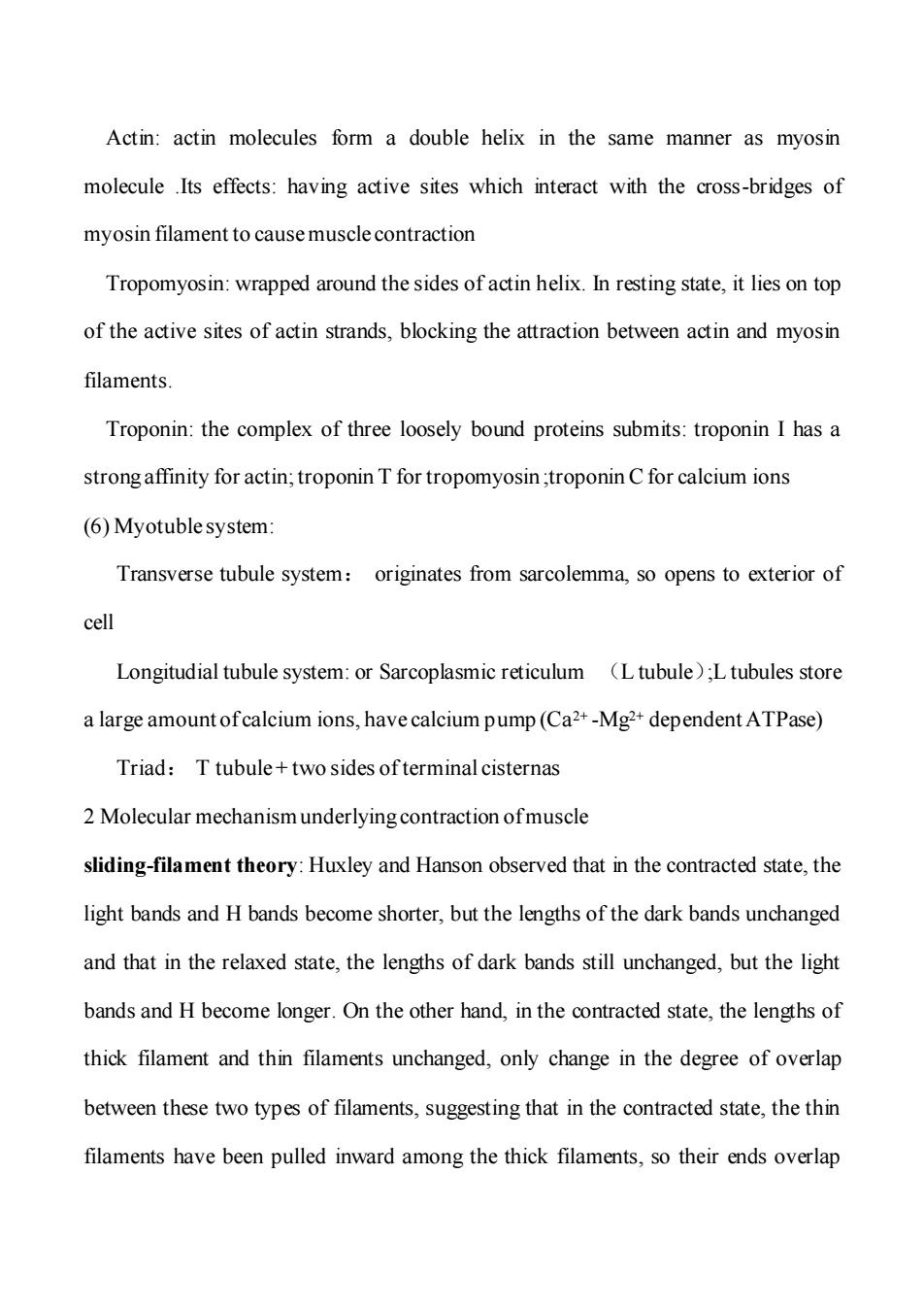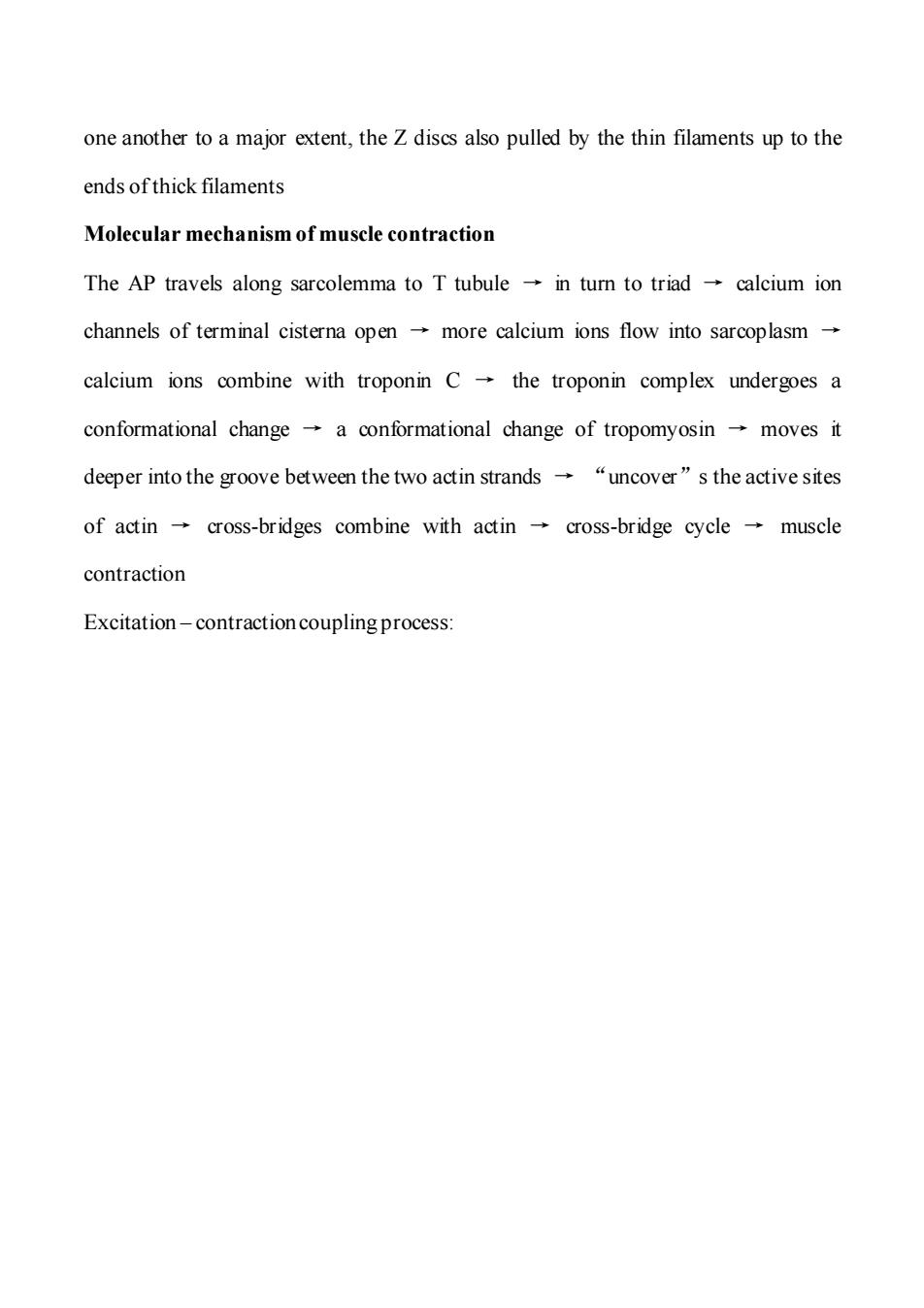
Chapter8 Contraction of Muscle 1.Physiologic anatomy ofskeletal muscle (1)The skeletal muscle fiber All skeletal muscles are composed of numerous fiber 10 to 80 micrometers in diameter)Each fiber is made up of small subunits(myofibril).Each fiber is innervated by only one nerve ending (the basic structure and functional unit for movement) (2)Myofibril:composed of myosin filament(thick myofilament,about 1500)and action filament thin myofilament,about 3000);Myosin filaments and actin filaments partially interdigitate and cause the myofibrils to have light and dark bands;H bands and M disc(at the middle of H bands)Z disc at the middle of light bands);from z disc,the actin filaments extend in both direction to interdigitate with myosin filaments (3)Sarcomere:the portion of myofibril that lies between two successive Z discs including 2 1/2 light band and one dark band.Sarcomere is the basic unit of contraction ofmuscle. (4)Cross-bridges:the protrudingarms and heads together functions of cross-bridges:A.myosin head functions as an ATPase enzyme which can cleave ATP B.combing with thin myofilament and using the energy to energize the contraction process (5)Thin filament:a complex,composed of three protein components actin, tropomyosin and troponin
Chapter8 Contraction of Muscle 1. Physiologic anatomy of skeletal muscle (1)The skeletal muscle fiber :All skeletal muscles are composed of numerous fiber ( 10 to 80 micrometers in diameter) .Each fiber is made up of small subunits( myofibril) .Each fiber is innervated by only one nerve ending (the basic structure and functional unit for movement) (2)Myofibril: composed of myosin filament( thick myofilament, about 1500) and action filament ( thin myofilament, about 3000); Myosin filaments and actin filaments partially interdigitate and cause the myofibrils to have light and dark bands; H bands and M disc( at the middle of H bands) Z disc ( at the middle of light bands); from z disc,the actin filaments extend in both direction to interdigitate with myosin filaments (3)Sarcomere: the portion of myofibril that lies between two successive Z discs including 2 * 1/2 light band and one dark band.Sarcomere is the basic unit of contraction of muscle. (4)Cross-bridges: the protruding arms and heads together functions of cross – bridges: A. myosin head functions as an ATPase enzyme which can cleave ATP B. combing with thin myofilament and using the energy to energize the contraction process (5) Thin filament: a complex, composed of three protein components actin , tropomyosin and troponin

Actin:actin molecules form a double helix in the same manner as myosin molecule Its effects:having active sites which interact with the cross-bridges of myosin filament to cause muscle contraction Tropomyosin:wrapped around the sides of actin helix.In resting state,it lies on top of the active sites of actin strands,blocking the attraction between actin and myosin filaments. Troponin:the complex of three loosely bound proteins submits:troponin I has a strong affinity for actin;troponin T for tropomyosin;troponin C for calcium ions (6)Myotuble system: Transverse tubule system:originates from sarcolemma,so opens to exterior of cell Longitudial tubule system:or Sarcoplasmic reticulum (L tubule):L tubules store a large amount ofcalcium ions,have calcium pump(Ca2+-Mg2+dependent ATPase) Triad:T tubule+two sides of terminal cisternas 2 Molecular mechanism underlying contraction ofmuscle sliding-filament theory:Huxley and Hanson observed that in the contracted state,the light bands and H bands become shorter,but the lengths of the dark bands unchanged and that in the relaxed state,the lengths of dark bands still unchanged,but the light bands and H become longer.On the other hand,in the contracted state,the lengths of thick filament and thin filaments unchanged,only change in the degree of overlap between these two types of filaments,suggesting that in the contracted state,the thin filaments have been pulled inward among the thick filaments,so their ends overlap
Actin: actin molecules form a double helix in the same manner as myosin molecule .Its effects: having active sites which interact with the cross-bridges of myosin filament to cause muscle contraction Tropomyosin: wrapped around the sides of actin helix. In resting state, it lies on top of the active sites of actin strands, blocking the attraction between actin and myosin filaments. Troponin: the complex of three loosely bound proteins submits: troponin I has a strong affinity for actin; troponin T for tropomyosin ;troponin C for calcium ions (6) Myotuble system: Transverse tubule system: originates from sarcolemma, so opens to exterior of cell Longitudial tubule system: or Sarcoplasmic reticulum (L tubule);L tubules store a large amount of calcium ions, have calcium pump (Ca2+ -Mg2+ dependent ATPase) Triad: T tubule + two sides of terminal cisternas 2 Molecular mechanism underlying contraction of muscle sliding-filament theory: Huxley and Hanson observed that in the contracted state, the light bands and H bands become shorter, but the lengths of the dark bands unchanged and that in the relaxed state, the lengths of dark bands still unchanged, but the light bands and H become longer. On the other hand, in the contracted state, the lengths of thick filament and thin filaments unchanged, only change in the degree of overlap between these two types of filaments, suggesting that in the contracted state, the thin filaments have been pulled inward among the thick filaments, so their ends overlap

one another to a major extent,the Z discs also pulled by the thin filaments up to the ends of thick filaments Molecular mechanism of muscle contraction The AP travels along sarcolemma to T tubule -in turn to triad -calcium ion channels of terminal cisterna open more calcium ions flow into sarcoplasm calcium ions combine with troponin C-the troponin complex undergoes a conformational change -a conformational change of tropomyosin moves it deeper into the groove between the two actin strands-"uncover"s the active sites of actin cross-bridges combine with actin cross-bridge cycle muscle contraction Excitation-contraction coupling process:
one another to a major extent, the Z discs also pulled by the thin filaments up to the ends of thick filaments Molecular mechanism of muscle contraction The AP travels along sarcolemma to T tubule → in turn to triad → calcium ion channels of terminal cisterna open → more calcium ions flow into sarcoplasm → calcium ions combine with troponin C → the troponin complex undergoes a conformational change → a conformational change of tropomyosin → moves it deeper into the groove between the two actin strands → “ uncover”s the active sites of actin → cross-bridges combine with actin → cross-bridge cycle → muscle contraction Excitation – contraction coupling process: